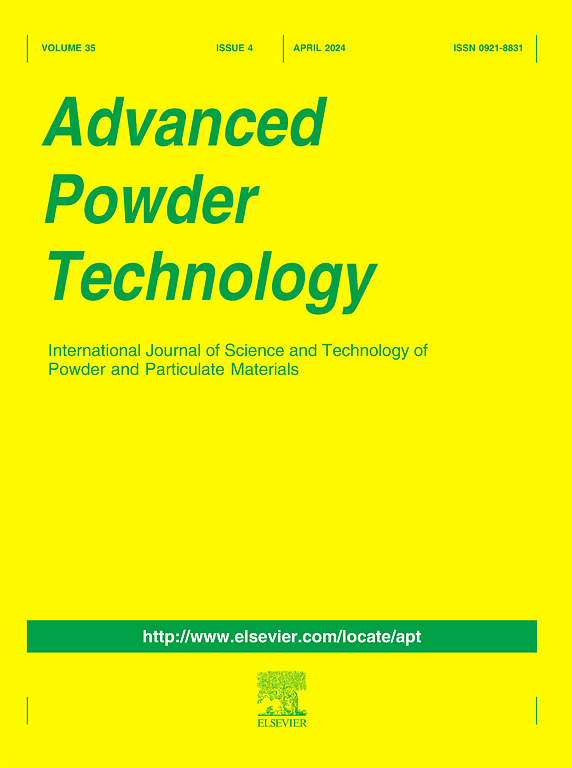Design and numerical simulation of a novel vortex structure for copper slag melting reduction process
IF 4.2
2区 工程技术
Q2 ENGINEERING, CHEMICAL
引用次数: 0
Abstract
A new type of vortex entrainment feeder structure has been established to address the problem of powder suspension and the inability to be quickly sucked up by the melt pool in the current mechanical stirring melting reduction tank. Numerical simulations of the particle motion behaviour and fluid flow characteristics of the four feeders have been carried out to determine the justification of the structural design. An experimentally verified numerical approach was established using the Eulerian model coupled with the Dense Discrete Phase Model (DDPM). The results show that the Type-4 (Double-flow channel) creates vortexes with significant effect, the shape of the entrainment vortex is uniform, and the velocity is high, the radial and axial particle concentration is 1.75 times and 1.44 times higher than that of the Type-1 (No-flow channel), and the particles are dispersed optimally, with a more extended residence mixing time. The mass flow variance of the particles was reduced by 55 % compared to the Type-1, the number of high-velocity particles was > 92 %, and the eccentricity distance of the positional distribution was shortened. The main driving forces for radial and axial particle dispersion are negative pressure entrainment of the gas phase and axial velocity difference. The variance values of the swirling number in the cylinder/cone zone were reduced by 91.3 % and 38.5 %, respectively, and the stability of the swirl flow field was improved.

新型铜渣熔炼还原涡结构的设计与数值模拟
针对目前机械搅拌式熔炼还原槽存在的粉末悬浮和不能快速被熔池吸收的问题,提出了一种新型涡旋夹带给料结构。对四种给料器的颗粒运动特性和流体流动特性进行了数值模拟,以确定结构设计的合理性。利用欧拉模型和密集离散相模型(DDPM)建立了一种实验验证的数值方法。结果表明:4型(双流通道)产生涡旋效果显著,涡旋形状均匀,速度高,径向和轴向颗粒浓度分别是1型(无流通道)的1.75倍和1.44倍,颗粒分散效果最佳,停留混合时间更长;与1型相比,颗粒的质量流量方差减小了55%,高速颗粒的数量为>;位置分布的偏心距离缩短。气相负压夹带和轴向速度差是颗粒径向和轴向分散的主要驱动力。柱锥区旋流数方差值分别降低了91.3%和38.5%,提高了旋流场的稳定性。
本文章由计算机程序翻译,如有差异,请以英文原文为准。
求助全文
约1分钟内获得全文
求助全文
来源期刊

Advanced Powder Technology
工程技术-工程:化工
CiteScore
9.50
自引率
7.70%
发文量
424
审稿时长
55 days
期刊介绍:
The aim of Advanced Powder Technology is to meet the demand for an international journal that integrates all aspects of science and technology research on powder and particulate materials. The journal fulfills this purpose by publishing original research papers, rapid communications, reviews, and translated articles by prominent researchers worldwide.
The editorial work of Advanced Powder Technology, which was founded as the International Journal of the Society of Powder Technology, Japan, is now shared by distinguished board members, who operate in a unique framework designed to respond to the increasing global demand for articles on not only powder and particles, but also on various materials produced from them.
Advanced Powder Technology covers various areas, but a discussion of powder and particles is required in articles. Topics include: Production of powder and particulate materials in gases and liquids(nanoparticles, fine ceramics, pharmaceuticals, novel functional materials, etc.); Aerosol and colloidal processing; Powder and particle characterization; Dynamics and phenomena; Calculation and simulation (CFD, DEM, Monte Carlo method, population balance, etc.); Measurement and control of powder processes; Particle modification; Comminution; Powder handling and operations (storage, transport, granulation, separation, fluidization, etc.)
 求助内容:
求助内容: 应助结果提醒方式:
应助结果提醒方式:


